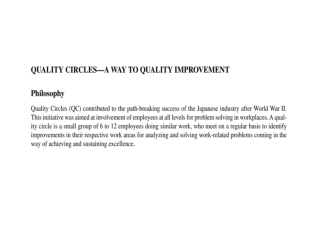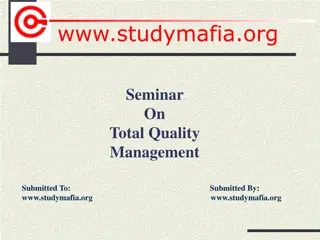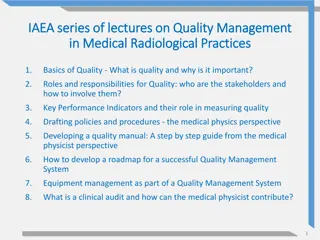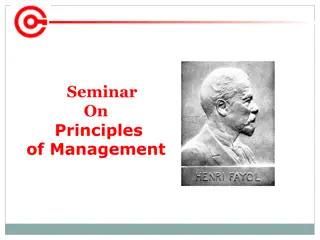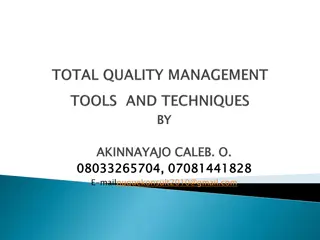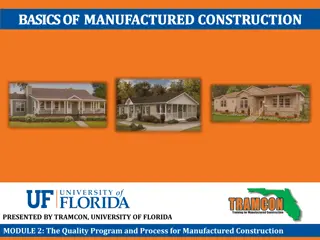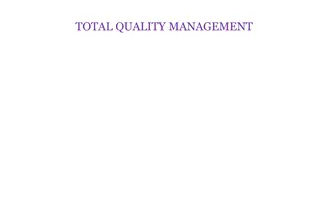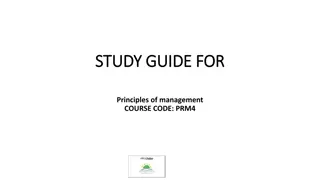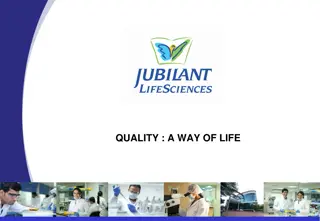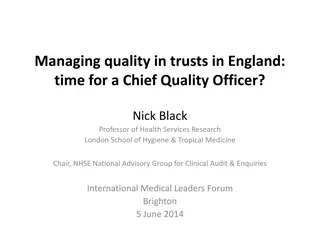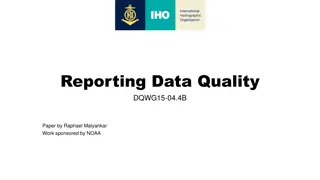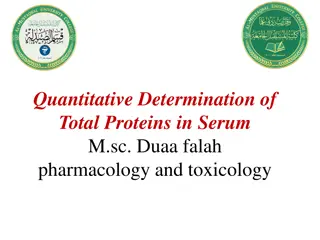
Total Quality Management (TQM): Origins, Concepts, and Elements
Total Quality Management (TQM) is a management approach focusing on quality services, with origins in America and significant impact in Japan. Learn about the history, concepts, and key elements of TQM for achieving competitive advantage and customer satisfaction.
Uploaded on | 0 Views
Download Presentation

Please find below an Image/Link to download the presentation.
The content on the website is provided AS IS for your information and personal use only. It may not be sold, licensed, or shared on other websites without obtaining consent from the author. If you encounter any issues during the download, it is possible that the publisher has removed the file from their server.
You are allowed to download the files provided on this website for personal or commercial use, subject to the condition that they are used lawfully. All files are the property of their respective owners.
The content on the website is provided AS IS for your information and personal use only. It may not be sold, licensed, or shared on other websites without obtaining consent from the author.
E N D
Presentation Transcript
DEFINITION OF TQM Total Quality Management is defined as the management of all aspects of quality services provided to the customer. These include quality of goods, delivery, price or service. It differs from the traditional quality concepts, Quality control and Quality Assurance, which are the current aspects of quality within the manufacturing industry with primary concern that all products are consistently manufactured to appropriate quality standards. The old view of quality is based on Acceptable Quality Level (AQL) which allows tolerable levels of faults in the system. This leads to high frequency of retesting, reworking or rejects which are very costly . The new quality concept, TQM, is basing on producing defect free goods or services and avoiding mistakes by adopting preventive measures from the start. This leads to cost saving and increased profits.
DEFINITION OF TQM. Unlike the traditional Quality concepts, TQM emphasis is a commercial one: Quality As A Means of Gaining Competitive Advantage. It recognises customer within the company as well as the external customers. It's application is focused on the individual's personal participation in the various activities of the company to ensure its survival. the internal
ORIGINS OF TQM TQM has evolved as a management concept out of the need by companies for continuous quality improvement and the critical importance of increased profitability and survival in the face of competitive challenges in the world market. The origin_ of TQM is American. and is associated with a few statisticians working in the Quality control section of Western Electric in the 1920s and 1930s. Notable among these early "quality gurus" were. Edwards Deming, Joseph Juran, Philip Crosby, Armand Feigenbaum, the man who coined the" term "Total Quality Control" and the late Kaoru Ishikawa of the Japanese Union of Scientists and Engineers.
ORIGINS OF TQM... However, although the total quality idea originated in America, the most profound effects of its application occurred in Japan from the early 1950s under the inspiration of W.E. Deming and Joseph Juran. Quality was built into a cornerstone of Japanese industry and became the Japanese "trick" Western companies have been trying to copy. The early quality gurus have been joined in the 1980s by Tom Peters in the US and Mike Robson in the UK. They have all developed many different types of programmes or formulae for implementing TQM and which one is used is often a matter of choice.
ELEMENTS OF TQM Although there are different types of programmes designed for implementing TQM, there are several elements common to all of them: Meeting Customer Requirements: This emphasizes the recognition of the exact requirements of the customer and satisfying them effectively and profitably. The customer is the ultimate judge of quality. Definition of the Customer: The end-user or supplier of a product or service is the person that is usually recognised as the customer. He is the external customer. In any organization there are also many internal customer/supplier relationship existing between departments, sections and co- workers. This is the internal customer relationship.
Prevention not Cure: This involves building quality into the system from the start rather than spending time and money correcting mistakes or sorting out rejects. Zero Defects: Customers today require defect free products - and services. It is hard to achieve but must be continually worked towards. The only way to achieve this is to ensure that all tasks are carried out "Right First Time". Contribution to profit: Doing things right first time is always more cost effective than making mistakes. Mistakes lead to rejects, reworking or lost opportunities. Therefore improvements in quality of service or product arc accompanied by an increased profitability for the organisation. Many companies have used the concept of
"Cost of Quality" in order to demonstrate the importance of TQM approach. Cost of quality is made up of failure costs (rejects, reworking, referrals and dissatisfied customers), appraisal costs (testing and inspecting) and prevention costs (supplier vetting, methods, systems and machines introduced to prevent defects and training in quality concepts). By implementing TQM, companies have been able to reduce drastically their cost of quality.
IMPLEMENTING TQM For successful implementation of TQM there are four essentials requirements: Management Commitment: The introduction of TQM must start with a firm commitment from the top of the organisation: the Chief Executive with support from all levels of management. The top management must be committed to the end result, setting targets and providing the authority and resources for the implementation of the programme. There must be concerted effort to change the culture and values of the organisation to that of a Quality Company. Employee Commitment and Teamwork:TQM can only be implemented through the contribution of the employees individually or in quality /improvement groups. Empowering all the organization's employees and making each responsible for quality is one of '.he ways to achieve a successful TQM programme. The contribution of each employee must be recognised and rewarded. Customer Orientation: The principle of customer orientation is aimed at recognising the requirements of both internal and external customers and working towards satisfying them. It is often forgotten that without the customer, no company will exist. For a successful TQM this principle must be well articulated and a programme set up for achieving a good customer relationship.
Quality System: A sound quality system is an essential foundation for TQM. A documented quality system ensures consistency for every product and every service. For companies to progress to TQM they 'must raise their quality system beyond the traditional quality systems of QC and QA. Quality systems have now progressed to the ISO 9000 Certification System. This is the system established by the International Organization for Standardization, a worldwide federation of national standard bodies, for the products of its members. The African equivalent is the ARSO 9000, a regional Certification System, modelled on the ISO Certification System. The requirements of these standards are higher than those of the 'currently used quality systems, QC and QA. The aim of establishing these international Certification systems is to ensure that goods and services moving in and out of any country should comply to the same standard.
TOOLS FOR IMPLEMENTATION OF TQM There is a variety of simple tools which are available for solving quality problems in an organisation. These include: team building, brainstorming and statistical means of identifying problems, collecting, analyzing and presenting data. These techniques will have to be learnt properly in order to be used effectively. Techniques of measuring cost of quality, customer satisfaction and other quality indices will also need to be learnt. Quality performance must be measurable qualitatively or quantitatively.
ORGANISATIONAL BENEFITS OF TQM Improvements in customer satisfaction Productivity Improvements (More effective/efficient use of equipment of materials) Greater initiative and entrepreneurship Improved team spirit Improved communication Attitude change Articulation, adoption and dissemination of a shared vision Articulation, adoption and dissemination of shared values Improved corporate image Improved profits.
TOTAL COMMITMENT TO QUALITY IMPROVEMENT The company acknowledges that there are better ways to achieve better results Quality improvement is continuous Quality improvement is always planned Quality improvement is achievement through i. Quality improvement projects using TQM problems solving techniques. ii. Establishing and pursuing total quality standards. iii. Individual quality improvement efforts.
COMMITMENT TO EMPLOYEE EMPOWERMENT IMPLIES: Creating employee ownership of the quality improvement process. Reliance on the creative abilities of all employees. Teaching employees new skills required in a TQM environment. Providing employees with opportunities to apply their skills. Providing rewards and recognition to employees for meeting the new standards of performance. Employee participation in decision-making through: oSuggestion schemes oQuality groups and oDelegated assignments
INDIVIDUAL BENEFITS OF TQM Empowerment New skills through training-increased personal effectiveness Increased Recognition and Rewards Enhanced job satisfaction Enhanced self Esteem
BENEFITS OF TQM The introduction of TQM in a company results in improvements in a number of critical areas: Profitability Cost Effectiveness Customer Relations Company Image Employee Morale and Sense of Belonging Productivity Communication Teamwork
CONCLUSION Quality plays a definite role as a means of gaining competitive advantage in business operations. The Japanese used the concept successfully to achieve their post-war industrial revolution. Their goods and services are today leaders in the world markets. Since the 1980s, companies in Europe and America have embraced TQM as a means of improving business performance as well as compete effectively with their Japanese 'counterparts. deregulation of the Nigerian economy and the consequent free flow of goods and services across the borders, local companies are facing stiffer competi- tion With the advent of
Conclusion .... than at any other time in history. Export opportunities abound but are dependant on the supply of goods and services that can compete effectively with those available in the world market. Only, those companies which are able to supply consistently high quality goods or services on time and at the right price as well as manage their costs efficiently can survive. There is, therefore, no better time for organisations in Nigerian introduce the technique of Total Quality Management than now.

